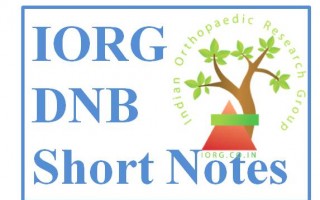What are the differential diagnosis of a thickened Trochanter?
-Implant
-Post Mc Murray’s Osteotomy
-Infection
-II degree Bursitis
Why do fixed deformities occur?
To conceal the deformity To maintain equilibrium Make up disparity of limbs Stabilize the hip
Which deformity you would prefer to have, if given a choice?
Flexion, Abduction and External rotation.
Why do you tell patient to extend the affected hip at the end of Thomas test?
To correct the over flexion done by flexing hip.
How do you measure for bilateral adduction deformity?
Draw midline vertical, and then a perpendicular to it. - Draw a line joining both ASIS. - In case of deformity they are not parallel, so go on adducting till they become Parallel and thus gives adduction deformity.
When do you have false negative telescopy?
When limb is in abduction.
When do you get false positive Telescopy?
- Joint laxity
- Soft bed
How do you assess bilateral external rotation deformity?
Make both hips in 90° flexion and then assess (Kothari’s Test)
What is axis deviation of Hip?
When hip is flexed it points to opposite shoulder, exception in slipped capital femoral epiphysis.
Can a patient instead of flexion, adduction and internal rotation, have flexion abduction & external rotation in deformed arthritic hip?
Yes, this could be due to
a) Constant adaption of the posture for relief of pain
b) Destruction of ilio femoral- Y.Ligament
c) Patient continued to bear weight on affected limb
What are the common sites of affection in the tuberculosis of hip?(foci)
Initial foci may be in, Metaphyseal, Epiphyseal, Trochanteric region, Babcock’s triangle or acetabular roof.
What is the path followed by cold abscess in hip?
In femoral triangle, medial lateral & posterior aspects of thigh, Ischiorectal fossa or pelvis. Rarely it may perforate ace tabular roof. The intra pelvic abscess may go, above levator ani & form inguinal abscess or may go beneath this muscle and form Ischiorectal abscess.
What are clinical features in favour of # trochanteric femur ?
- Older age group
- Significant trauma, direct injury
- Broad, irregular tender trochanter
- Marked external rotation & shortening
- Bitrochantric compression & tenderness in trochanteric region
- Transmitted movements are absent
When was excision arthroplasty described?
In 1950 by Girdlestone. He described excision of femoral head, neck, proximal part of trochanter and acetabulum rim of deep infections
What is Calcar?
A dense vertical plate of bone extending from posteromedial portion of shaft under lesser trochanter radiating laterally to greater trochanter reinforces neck postero inferiorly.
Also defined in an article by Dr Griffin in CORR journal is as follows: The calcar femorale is a spur of thickened bone that lies deep to the lesser trochanter but posterior to the neutral axis of the femoral neck. The calcar is thickest medially where it joins the compression buttress of the neck and gradually thins as it passes laterally. X-ray films taken at right angles to the neutral axis of the femoral neck best portray the calcar femorale, which stands out like a solid bone spur as if viewing along the line of a picket fence. The presence of the calcar femorale affects the configuration of peritrochanteric fractures. It should not be confused with the primary medial compression buttress of the femoral neck.
What is a Dimon & Hughston procedure?
Hughston, describes an unstable intertrochantric fracture as one with communication of calcar & posterior arch along the shaft. So a medial continuity restoration is essential for successful fixation. So a transverse osteotomy of shaft is made & distal portion medialised.
How do you conservatively treat a case of fracture trochanter?
By means of Hamilton Traction.
Why do you consider that the patient is a case of old fractures of neck femur? - Tenderness over mid inguinal point
- Absence of transmitted movement at neck but presence at trochanter
- Telescopic Test positive
- Crepitus is present.
Which is the commonest deformity to occur and why does & old fracture neck femur, patient develops an abduction deformity?
It is Adduction. It happens so, when he tries to bear weight and become ambulatory.
Can a patient of # neck femur (old) have an active SLR?
Yes, it is possible in impacted fractures or when capsular fibrosis, has occurred.
How does a case of fracture neck femur differ from fracture trochanter on examination?
Characteristic # Neck Femur #Trochanter
Age Patient.older(than #p/t femur) younger by decade
Sex Females:Male is same Male>Females
History Trivial injury R.T accident
Fall on buttocks direct lateral impact
Ecchymosis/Bruising Less More on lateral aspect
Tenderness Mid inguinal point Lateral aspect hip
External Rotation Lesser than # p/t femur marked externally rotated
Trochanter Normal Broadened, Tender irregular
Trasmitted Movements Present Absent
Telescopic Test Positive in old case Negative
Naraths sign Positive Negative
Chienes test -convergence towards affected site -converge to affected site but Angle is less
Bitrochantric compression pain at mid inguinal point at trochanter
Supratrochantric Shortening Less than trochanter More
Complications Non-union Mal-union
How do you reduce a fracture neck femur?
Leadbetter’s Manoeuvre-traction in a flexed hip & knee followed by abduction internal rotation Along with extension with a stabilized pelvis
When does neck start resorption?
By third week.
Why does the neck get resorbed?
As it is an intraarticular part of bone which is cancellous & least vascular hence the creeping substitute Is delayed & poor.
Why there is increase incidence of Non-union in fracture neck femur & what is the incidence?
- Due to loss vascularity
- Intraarticular portion
- Increased micro motions
It’s incidence is up to 40%
What is the fracture line in fracture neck femur?
Spiral.
Who gave the first implant fixation for fracture neck femur?
Von Langenback.
What is Garden’s Index?
Compression trabeculae forms & angle of 160° in AP & 180° in lateral view. This ratio is known as Garden’s Index.
What is It’s Significance?
It gives the idea of anatomic reduction in cases of fracture neck femur.
What the role of anteversion, retroversion in a good reduction?
With retroversion there intoeing & increased incidence of dislocation.
What is Singh & Maini’s Index? What is it’s significance?
The arrangement of the trabeculae in the head & neck of femur is in the form of Principle tension
Principle compression
Secondary tension
Secondary compression & tensile trabeculae.
Their loss is seen in osteoporosis as
Grade 6 – normal of
Grade 5 – loss of secondary trabeculae
Grade 4 – loss of traction trabeculae
Grade 3 – principle tension lost
Grade 2 – Primary compression lost
Grade 1 – few trabeculae left
.
For Random Exam Questions and Answers (REQA) part II - CLICK HERE













 India-Orth
India-Orth